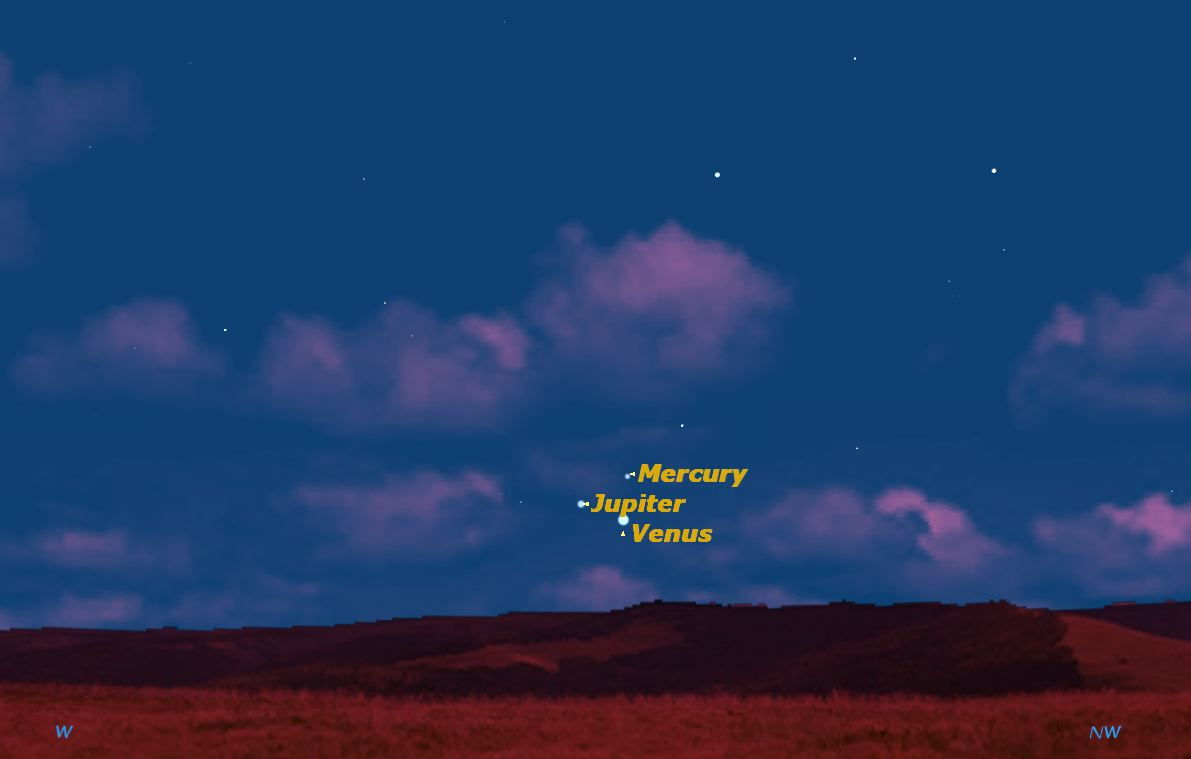See Jupiter, Venus and Mercury Dance in Sunset Sky

Take a look at the western sky just after sunset this week, and you’ll see an amazing sight: three bright planets in close formation.
The giant planet Jupiter is moving behind the sun, so is dropping rapidly in the western sky. Mercury and Venus, much closer to Earth, are just emerging from behind the sun, moving in the opposite direction from Jupiter. The three planets meet this week, weather permitting. Such a tight grouping of planets in the night sky won't come again until 2026.
Find yourself a location with a very low western horizon. Go there just after sunset. A small 7x50 or 10x50 binoculars will help, but don't point it in the direction of the sun until it is well below the horizon.
Venus is the brightest of the three, and so should be the first that you see, just above and to the left of the point where the sun has just set.
Astronomers use an upside down scale to measure brightness. The brightest stars are magnitude 1; the faintest the human eye can see are magnitude 6. Really bright objects, like these planets, end up with negative brightness. Tonight Venus will be magnitude –4.
Once you’ve spotted Venus, look for Jupiter nearby. Jupiter will be two magnitudes fainter than Venus, magnitude –2, still extremely bright.
Finally, try to spot the third planet, Mercury, slightly fainter than Jupiter at magnitude –1. Tonight (May 22) and tomorrow night it will be just to the right of Venus, moving upward and to the left more rapidly than Venus.
Breaking space news, the latest updates on rocket launches, skywatching events and more!
Try to watch these three planets every night for the next week, and you’ll see them appear to circle around. On Sunday night (May 26) they will form a perfect equilateral triangle, two degrees on a side.
Mercury continues to rise and Jupiter continues to set so that by the middle of next week they will appear in a straight line with Mercury highest and Jupiter lowest, brilliant Venus in the middle.
We don't often get to see three planets in such close proximity and see how rapidly they appear to move.
Editor's note: If you snap an amazing picture of the three planets or any other night sky view that you'd like to share for a possible story or image gallery, send photos, comments and your name and location to Managing Editor Tariq Malik at spacephotos@space.com.
This article was provided to SPACE.com by Starry Night Education, the leader in space science curriculum solutions. Follow Starry Night @StarryNightEdu. Follow us @Spacedotcom, Facebook or Google+. Original article on SPACE.com.
Join our Space Forums to keep talking space on the latest missions, night sky and more! And if you have a news tip, correction or comment, let us know at: community@space.com.

Geoff Gaherty was Space.com's Night Sky columnist and in partnership with Starry Night software and a dedicated amateur astronomer who sought to share the wonders of the night sky with the world. Based in Canada, Geoff studied mathematics and physics at McGill University and earned a Ph.D. in anthropology from the University of Toronto, all while pursuing a passion for the night sky and serving as an astronomy communicator. He credited a partial solar eclipse observed in 1946 (at age 5) and his 1957 sighting of the Comet Arend-Roland as a teenager for sparking his interest in amateur astronomy. In 2008, Geoff won the Chant Medal from the Royal Astronomical Society of Canada, an award given to a Canadian amateur astronomer in recognition of their lifetime achievements. Sadly, Geoff passed away July 7, 2016 due to complications from a kidney transplant, but his legacy continues at Starry Night.

